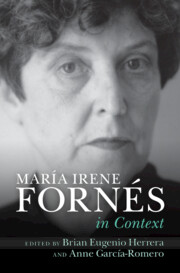Book contents
- María Irene Fornés in Context
- María Irene Fornés in Context
- Copyright page
- Dedication
- Contents
- Figures
- Notes on Contributors
- Acknowledgements
- A Chronology of María Irene Fornés’s Life and Work
- Introduction
- Part I Places and People
- Part II Theatre
- Chapter 11 Stage Direction and Design
- Chapter 12 Off-Off-Broadway
- Chapter 13 Environmental Theatre
- Chapter 14 Music Theatre
- Chapter 15 Performance Art and the Postdramatic
- Chapter 16 Translation and Adaptation
- Part III Culture, Society, and Politics
- Part IV Legacy
- Further Reading
- Index
Chapter 16 - Translation and Adaptation
from Part II - Theatre
Published online by Cambridge University Press: 27 August 2025
- María Irene Fornés in Context
- María Irene Fornés in Context
- Copyright page
- Dedication
- Contents
- Figures
- Notes on Contributors
- Acknowledgements
- A Chronology of María Irene Fornés’s Life and Work
- Introduction
- Part I Places and People
- Part II Theatre
- Chapter 11 Stage Direction and Design
- Chapter 12 Off-Off-Broadway
- Chapter 13 Environmental Theatre
- Chapter 14 Music Theatre
- Chapter 15 Performance Art and the Postdramatic
- Chapter 16 Translation and Adaptation
- Part III Culture, Society, and Politics
- Part IV Legacy
- Further Reading
- Index
Summary
In a certain sense all theatre is an act of translation. We translate written and devised texts into stage action, characters are translated into beings, images are translated into physical spaces. In this essay, Adam Versényi explains how, because she was a playwright writing primarily in her second language throughout her career, María Irene Fornés was simultaneously writing and translating, with each practice inextricably linked to the other. Drawing upon his on own professional practice as a dramaturg and translator, Versényi argues that not only does an understanding of translation provide greater access to Fornés’s creative process but also that a careful reading of Fornés’s work informs the topic of translation itself. As example, Versényi explores how Fornés’s playwrighting method and the process of theatrical translation affect two notably distinct translations of Fornes’s The Conduct of Life (1985).
Keywords
Information
- Type
- Chapter
- Information
- María Irene Fornés In Context , pp. 171 - 180Publisher: Cambridge University PressPrint publication year: 2025
Accessibility standard: WCAG 2.0 A
Content Navigation
Allows you to navigate directly to chapters, sections, or non‐text items through a linked table of contents, reducing the need for extensive scrolling.
Provides an interactive index, letting you go straight to where a term or subject appears in the text without manual searching.
Reading Order & Textual Equivalents
You will encounter all content (including footnotes, captions, etc.) in a clear, sequential flow, making it easier to follow with assistive tools like screen readers.
You get concise descriptions (for images, charts, or media clips), ensuring you do not miss crucial information when visual or audio elements are not accessible.
You get more than just short alt text: you have comprehensive text equivalents, transcripts, captions, or audio descriptions for substantial non‐text content, which is especially helpful for complex visuals or multimedia.
Structural and Technical Features
You gain clarity from ARIA (Accessible Rich Internet Applications) roles and attributes, as they help assistive technologies interpret how each part of the content functions.
